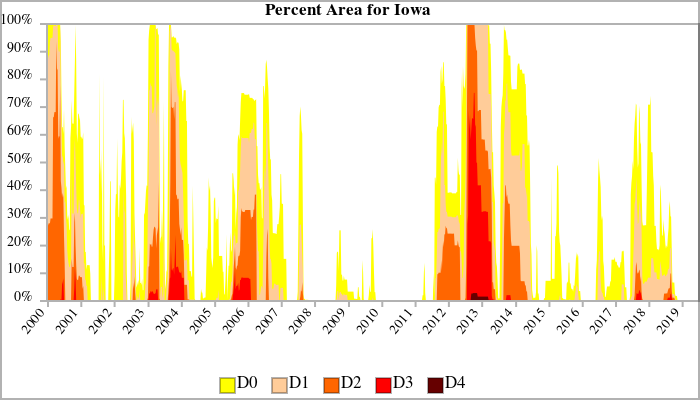Drought of 2011
Jefferson County
Starting in January 2011, Iowa began to experience a season of extreme weather. A blizzard covered all of Iowa with a statewide average of 7.4 inches of snow. From Fairfield to the Quad Cities, snowfall was well into the double digits. In the early spring of 2011, the melting snow brought the expected flash flooding that much of Iowa has come to expect. However, by the end of the summer, Jefferson County and much of the rest of Iowa would be in the middle of a drought that would last through the following year.
But first there was the flooding. By early June, much of the state was dealing with severe flooding. Southeast Iowa was hit the hardest with Keosauqua and Bloomfield having roughly 15 inches of rain. Fairfield was slightly drier, coming in at nearly 9 inches of rain by the end of the month. Heavy rain continued across the state causing the Missouri River to flood southwest Iowa.
.
The weather quickly changed in July 2011, which would become the hottest July on record. Fairfield, like much of southeast Iowa, would see little rain in July, totaling 0.17 inches or 5% of the average rainfall. The heat only worsened the drought condition. By August, the drought would continue with just under 2 inches of rain. The highest temperature in Fairfield at 106 degrees, was the hottest recorded since July 2006. Due to the drought, harvest season wrapped up early with 98% of the soybean crop out by October.
Relief from the drought did not come in 2012. From May to September, Fairfield did not have any significant rainfall. Each month the rain totals were less than 5 inches and would dip to 1.22 inches in the extreme July heat. Again, Fairfield reached record high temperatures of 107 degrees, a number not seen since July 1999. For nearly the entire month, temperatures were upwards of 90 degrees. The coldest day was still hot at 85 degrees. Iowa’s crops and pastures were rated the worst for the season since 1989. Crop yields decreased 20% for corn and 10% for soybeans compared to the 4-year averages.
In Fairfield, the effects of the drought played a significant role in how the farmers dealt with their crops. Avi, a local farmer, negotiated his use of a shared pond with his neighbor. In an interview, Avi said,” I spent 30 hours last week in 106-degree heat index hauling water on the back of a truck. I only have a 200-gallon tank, so it’s just back and forth, back and forth.” This work was for the benefit of two acres worth of fruit, chestnut, and hazelnut trees. The pond, only 6-7 feet deep, is used to sustain both Avi’s orchard and his neighbor’s farm.
According to his neighbor, the pond would last them until next year with no rain. “But I’m not entirely sure his calculations are correct. And so when, you know, it’s a race against time, I guess – you know, the weather should turn around in the fall, right?”
While less severe, the drought would continue in Fairfield until 2014.

Image Source: drought.gov
Sources: Harry Hillaker, “2011 Iowa Weather in Review,” National Weather Service, 2011; “The Drought of 2012 in Iowa,” Iowa Dept. of Agriculture and Land Stewardship; “2011 warmer, drier than usual,” Globe Gazette, 2012; “Fairfield, Iowa,” U.S. Climate Data, 2011, 2012, 2013, 2014; “Effects of Midwest Drought Spread Across Nation,” National Public Radio, 2012.
